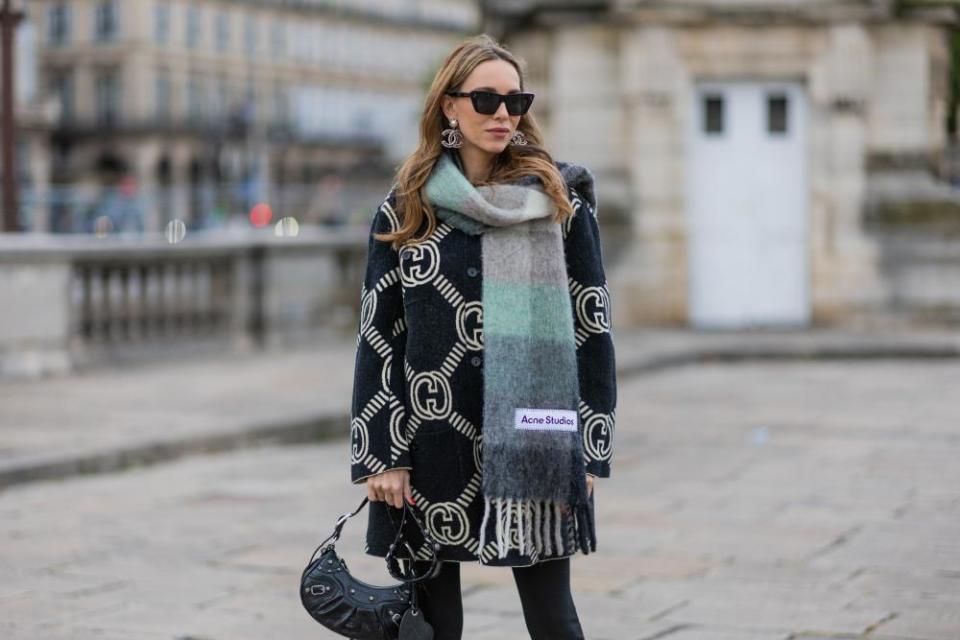£240 rainbow scarf is latest splurge of choice to beat the blues
As the temperature drops, the days grow darker and winter draws closer, we may find ourselves craving a dependable boost of warmth and good cheer. But would you pay nearly 250 quid for it?
Some people are, with Acne Studios’ oversized plaid scarf ubiquitous on the streets of London and farther afield. The Swedish fashion house has been selling the distinctive wool-blend item since 2019, in an ever-increasing number of colourways that routinely sell out within a month – but, at £240, it is very much a status symbol.
Even fashion insiders have emphasised its non-essentialness. “Is it necessary to have a £200-plus scarf? Not really,” said the stylist and content creator Oluwaseun in her recent TikTok review of the scarf, exploring whether it is worth the money.

Yet a recent uptick in sales and online chatter – not to mention, the proliferation of high-street knockoffs – suggests that, for those shoppers with money to spare, the statement scarf is the splurge of choice in the current economic climate.
A spokesperson for Acne says sales have been growing every year and continue to grow. On TikTok, the #acnescarf hashtag has had more than 2.5m views, as users style their purchases, debate whether to invest or discuss the best-quality “dupes”.
The item has become so omnipresent on city streets that a Twitter user in Brooklyn, New York, joked last week that they were “taking a shot every time I see someone wearing the rainbow Acne scarf”.

“It’s everywhere right now,” says Sian Clarke, a personal stylist in London. She says the item’s appeal is its versatility: equally suited to a minimalist monochrome wardrobe or one already full of colour, and it can be worn throughout the winter. “It’s really friendly to every kind of style.”
For those just wanting an outfit refresh, imitations are selling at Arket, Whistles, Cos, & Other Stories and more high-street shops for about £80. Cheaper versions have also been popular at Mango, Accessorize and on Asos and Amazon, while a lookalike retailing at Primark for £8 has been circulating on TikTok as a cost-conscious – if not climate-friendly – alternative.
While acknowledging that £240 seems excessive for a scarf, Clarke says that, relative to many designer items, it was easy to get more wear out of an accessory: “People would spend £240 on a handbag on the high street … You’re guaranteed to need a scarf every year.”
Not only that: as status symbols go, with its highly conspicuous label, the Acne scarf offers more bang for your buck than a luxury item you would recognise only from the inside tag. “It’s a really obvious brand to see: that’s another tick box in terms of why people go for it,” says Clarke.
But, she adds, the price tag also reflects quality, with the authentic Acne scarf made of a blend of alpaca, wool, nylon and mohair: “That’s going to be so much warmer than a wool scarf.”
“If they do have a bit of spare income, they can spend it on keeping warm and looking, and feeling good … You can kind of justify it,” says Clarke.
Some Acne scarf owners have reported using theirs as blankets, in air-conditioned offices or on planes, or as decorative throws in the home.
It suggests a new economic indicator, and an update on the “lipstick index”. In past recessions, sales of cosmetics have gone up as consumers downsize their treats; as we stare down one this winter, we may be asking our luxuries do at least double-duty.
For many, the compromise has been shopping secondhand, with the fashion marketplace Depop reporting a 42% increase in searches for “Acne scarf” compared with last winter.
A spokesperson suggested that the spike in searches for high-ticket retailers spoke to consumers weighing quality over quantity during the cost of living crisis, and “naturally becoming more conscious about sourcing timeless pieces at a lower cost”.
Research by Depop found that more than half of users polled said they had already turned to second-hand shopping to save money this year.
Despite concluding in her TikTok review that the Acne scarf did not warrant the £240, Oluwaseun said she did shell out – but only after finding a big discount via a friend. “I would never have paid full price,” she says.
With the wide range of imitators available, says Oluwaseun, “there’s a running joke online that if anyone has a real Acne scarf they tie it so that you can see the label”.
But after finally splurging on hers, she said she is not bothered to find herself part of a crowd. “I wear what I like to wear, I don’t care if anyone thinks it’s fake – it keeps me warm, and it looks cute.”

